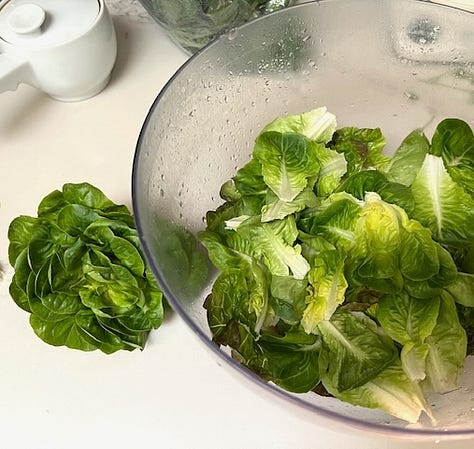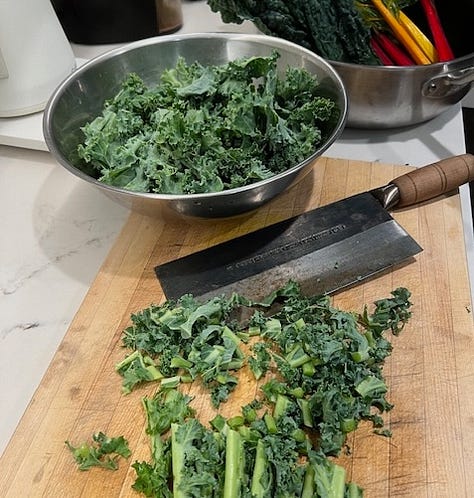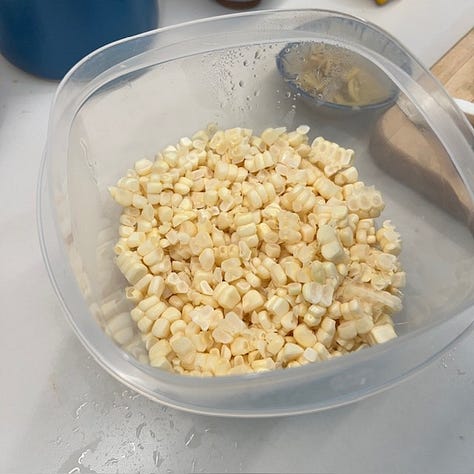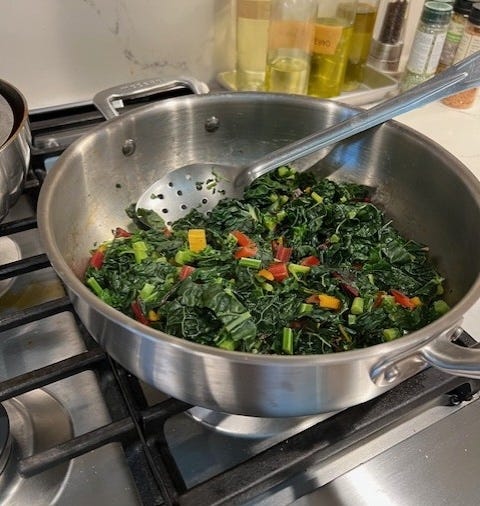How to deal with vegetable cooking fatigue? My strategies and recipes (part 2)
+ 6-day dinner meal plan + lunch solutions + simple sweet treats
Hello everyone!
If you’re celebrating the long weekend in America, I hope you’re having a fabulous last hurrah of summer. I’ve yet to kick Covid-19 but feel ok with my moderate symptoms (I’m typing cogently to you and have been scoring well on the daily Wordle). I’m jealous of Rory’s mild case.
The low-grade sinus pressure and congestion have not prevented me from further answering Erin’s question about doable ways to craft a healthy, wholesome diet and incorporate it into a busy, family filled life.
Mark Twain is often quoted for saying, “Everybody talks about the weather, but nobody does anything about it.” Similarly, plenty of people prescribe healthy diets and eating more veggies without suggesting plausible ways to do so.
But, let’s face it. Working more vegetables into your rotation in a long-lasting manner can seem like an uphill slog. The idea of prepping dinner in 15 or 30-minutes works if you can afford an assistant, buy a lot of packaged products, or have Rosie the Robot like the Jetsons did.
I can’t afford the first, don’t like the flavors and ingredients of the second, and am waiting for the third. Until Rosie or AI can create bespoke meals for me affordably, I have to rely on myself to create a cooking situation that works best for me and my taste buds.
Last week, I wrote about about how I shop for vegetables and lean into a “bean of the week”. I forgot to add to that, that dal is an easy, fast way to enjoy legumes; I cooked 12 ounces of red lentils last Sunday and it paid off in dinner and lunch dividends for days!
Now, let’s chat about what you can do with those vegetables to stay out of the inevitable vegetable cooking rut. For instance:
How to deal with the cooking fatigue?
How to avoid that rut?
How can you cook faster and better?
What about a sample meal plan or weekly cooking blueprint?
Make meal building blocks
Restaurant chefs make things look easy because they and their staff prep ingredients ahead of opening the door for a service. They’re ready to “fire” (refresh or assemble ingredients) when orders arrive. You don’t have to run a restaurant to borrow that idea to help yourself throughout the week.
To that end, pre-prep meal components each week to assemble future meals with less mess. You can mix and match stuff from the fridge and get creative. You may surprise yourself.
When I open the French doors or drawers of my two fridges, I look at them like glorious food closets packed with an edible ensemble waiting to come together to make something that I know I’ll like. That’s because I had a hand in selecting and cooking those meal building blocks.
Recipes mentioned below are in this newsletter (for free/everyone or paid subscribers only), on my website, or in my books, which you may already have.
🥬 » Invest 1 Hour
Each week, I spend about 1 hour cleaning, chopping, and/or cooking vegetables to save myself hassle during the rest of the week. What I do depends on what I purchase. Some ideas:
Lettuce: Separate the leaves, then wash and spin them so they’re ready for salads or wraps. Store them in plastic zip top bags (or a dedicated plastic shoe bin) and keep refrigerated.
Cilantro, mint, shiso, Viet coriander (rau ram), and Viet balm (kinh gioi): Trim a bit from the stem end, wash the bunch, and pat sprigs dry with a clean dish towel. Then treat them like a flower bouquet: put 1 to 2 inches of water in a container, put the herbs in and cover loosely with a thin produce bag and put in the fridge.
Basil: If it came in packaging, put it in the fridge. If it came without packaging, use it very soon, or, trim the stem end, and put in a container with water and loosely cover with a plastic bag BUT keep the basil on the counter, at room temperature. Wash basil before using.
Chard and kale: Wash then chop. Steam-saute the greens (use about 1/8-inch water, a few pinches of salt and a big pinch of baking soda to maintain bright color). Keep refrigerated. The greens can be mixed with egg and fried up into pancakes or dressed with sesame salt (see recipes in Ever-Green Vietnamese). Soft kale is ideal for EGV’s kale salad so keep the leaves in big pieces in a bag.
Corn: Cut kernels off the cob for stir-fries like this and this. Freeze the cobs to add sweetness to future broths.





Broccoli or cauliflower: Trim then into florets so you can just toss them into dishes later on during the week. Store in a plastic bag or container.
Quick pickle: When you have the energy for chopping, make a quick pickle! It’s a stealth ingredient for meals. Eat the pickle, use the brine for a second batch or add to a salad dressing. Viet daikon carrot pickle is my life raft. And, I’m about to restock my supply of green cherry tomato and lemongrass pickle.
Potatoes (and/or carrots): Microwave them. I use AnyDay cookware with a scant 1/4 inch of water. Whatever to be cooked should be cut into similar size. If there’s a density difference, I cut the denser (carrot) smaller than the less denser vegetable (potato). Above, the vegetables microwave-steamed for 8 minutes on high power. Add the veggies to a curry, panfry them or turn them into potato salad later in the week. I’m not a huge microwave-r but AnyDay cookware lets you cook, store and serve in the bowls; the lids are flat and the bowls stack in the fridge. They’re a worthy splurge.
What about pre-cut or pre-washed vegetables? Have no shame in using them to save time. Check the best-by date to gauge freshness.
🍚 » Big Batch Rice
Buying pricey pre-cooked rice is ridiculous. The packaging probably costs more than the rice!
Figure out how much rice your family eats in one sitting, then cook enough rice to get you through 3 meals. Use a rice cooker so you don’t have to mind it. Rice reheats beautifully, you can turn it into fried rice, add it to bean burger mixtures, or make rice bowls. I cook brown jasmine rice by Three Ladies or Koda Farms brown short grain rice. Or, cook more rice, like enough for 5 or 6 meals and freeze it in portions.
🥘 » Meal Plan around 2 Mains
Sustainable home cooking (e.g., something that you can keep doing!) relies on pre-cooking. Always cook with an eye on the future. Each week, focus on 2 mains that can be repurposed during the week in ways that won’t bore you and your family. For example, the white bean playbook from last week could be combined with something that’s grilled.
Below is a sample 6-night dinner plan, lunch solutions, and sweet treat ideas to seed doable cooking anytime.






